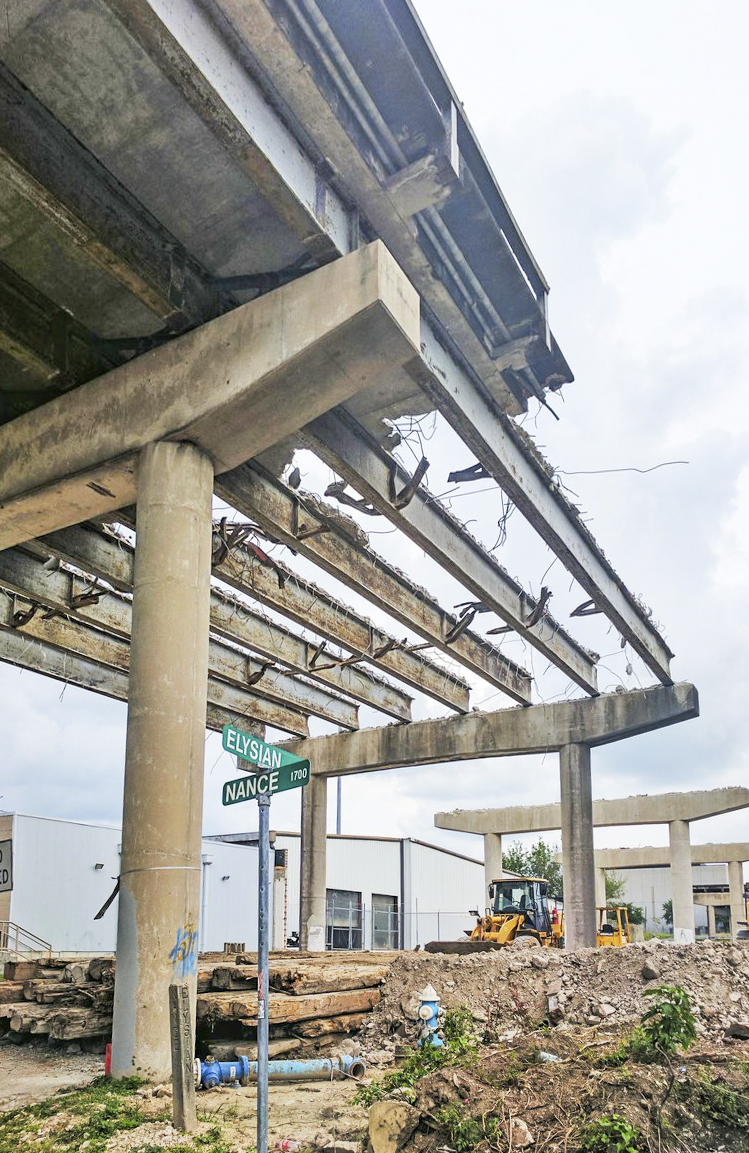ELYSIAN VIADUCT WORK UNEARTHS HISTORIC HOUSTON HERITAGE TRASH PILE  The real value of the long-buried dump uncovered by the ongoing replacement of the Elysian St. bridge over I-10 and Buffalo Bayou, write Doug Boyd and Jason Barrett this week in the Chronicle, is in the opportunity it provides “to document the often-unwritten parts of our industrial heritage.” The dump, apparently built up over the early half of the 1900s in a former gully, serves as a springboard for the authors to talk trash — Houston, they write, was one of the first cities to adopt widespread municipal garbage incineration, and lagged decades behind as most cities chose to stop doing it out of concern for public health. Spots like the one under Elysian St., they add, help fill in the gaps of knowledge of what happened to all the other trash that didn’t end up in a city incinerator or landfill — and who tended to live nearby. [Houston Chronicle; previously on Swamplot]  Photos: Adam J Williams
The real value of the long-buried dump uncovered by the ongoing replacement of the Elysian St. bridge over I-10 and Buffalo Bayou, write Doug Boyd and Jason Barrett this week in the Chronicle, is in the opportunity it provides “to document the often-unwritten parts of our industrial heritage.” The dump, apparently built up over the early half of the 1900s in a former gully, serves as a springboard for the authors to talk trash — Houston, they write, was one of the first cities to adopt widespread municipal garbage incineration, and lagged decades behind as most cities chose to stop doing it out of concern for public health. Spots like the one under Elysian St., they add, help fill in the gaps of knowledge of what happened to all the other trash that didn’t end up in a city incinerator or landfill — and who tended to live nearby. [Houston Chronicle; previously on Swamplot]  Photos: Adam J Williams





Any interesting stuff that could be made into art?
Of course…. In order to connect trash with racism, you gotta dig deep…..
I guess the free market couldn’t find away to get rid of all the trash it makes.
I would suspect that the trash incinerators were spaced-out along the Buffalo Bayou for some perfectly logical reason such as that it was more efficient to transport loaded carts down a gentle negative grade and empty carts up the same gentle positive grade. There was a fair bit of pre-existing industry along the Buffalo Bayou, too, and in that era industry was notoriously dirty and lower elevations were notorious for flooding; in cities throughout the United States, people with means had already begun moving toward leafy suburbs on high and dry ground. It should come as little surprise then, that anybody living in close proximity to an incinerator site was likely to be at least a little poor.
.
Glancing at a topographic maps from 1922 and cross-referencing to Google Earth’s earliest historical images from 1944, the Fourth Ward Incinerator was at the very edge of urban development and at the top of a deep ravine which got filled in. Indeed, this would have adversely impacted some of the neighborhood, and indeed it was predominantly black. The Thompson Garbage Crematory was in a purely commercial/industrial district opposite downtown, right off of the San Jacinto Street bridge. The Risely Refuse Crematory was at the Jensen Street bridge, the easternmost bridge across Buffalo Bayou at the time; it would have adversely impacted some nearby residences. The Velasco Street Incinerator was also in a primarily industrial area and few residences would’ve been impacted.
.
I attempted a search for the article cited by the Chronicle, but they’re mostly behind paywalls. I did find some references to the article in other sources, and there seems to be a discrepancy in the number of incinerators. My source, from Kansas University, says eight. The Chronicle says five; and it maps only four. Goodness knows why the other(s) are omitted. I’m tempted to say that the Fourth Ward site could have been located elsewhere and served its function adequately, but its hard to render judgement without knowing the locations of the other sites and perhaps other relevant circumstances.
.
Does anybody have a link to the full text of the original 1983 Robert Bullard article, “Solid Waste Sites and the Black Houston Community”?
Toby, I knew Niche could do it! I just won $20 on a bet.
@Niche, using my limited access to ProQuest, JSTOR, and MUSE to search, I found the full content of other journal articles by Bullard on this topic, but only bibliographic references to this specific one. You’re looking for Sociological Inquiry, volume 53, spring 1983, pp. 273-288. If you have a legitimate scholarly interest, you can request access to a PDF of the article from the publisher: http://onlinelibrary.wiley.com/doi/10.1111/j.1475-682X.1983.tb00037.x/full
It would go without saying that a dump is going to be in a poor area, because the cost of land is less.
.
“poor” isn’t a race. So why would putting a dump in a poor area be racist?